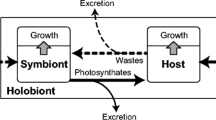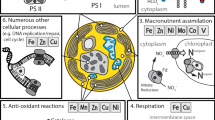Abstract
Symbiotic dinoflagellates (`zooxanthellae') typically release short-term photosynthetic products and have enhanced photosynthesis when exposed to extracts of host tissue. Published evidence has indicated that free amino acids (FAA) at concentrations exceeding 40 mM are responsible for these `host factor' effects on zooxanthellae from sea anemones and corals. We have compared the ninhydrin-positive FAA concentrations of extracts of the symbiotic sea anemone Aiptasia pallida with their efficacy in eliciting these responses and found little effect on carbon release by freshly isolated A. pallida symbionts at concentrations up to 0.6 mM, the highest concentration of our samples. Extracts of the coral Montastraea annularis induced release from these algae at less than 0.1 mM FAA, but there was no correlation between total ninhydrin-positive FAA concentration and `host factor' activity. However, all of these preparations stimulated photosynthesis. We tested a range of concentrations (≤50 mM) of glycine, alanine and glutamic acid with the isolated A. pallida symbionts. There was a significant increase in the release of fixed carbon with increasing alanine concentrations, but not with the other two amino acids. There were no effects on photosynthesis. Our observations support other reports indicating that other compounds , or specific amino acids such as taurine and the mycosporine-like amino acids, are responsible for `host factor' effects.
Similar content being viewed by others
REFERENCES
Cook, C. B., 1983. Metabolic interchange in algae-invertebrate symbioses. Int. Rev. Cytol. Suppl. 14: 177–210.
Cook, C. B., C. F. D'Elia & G. Muller-Parker, 1988. Host feeding and nutrient sufficiency for zooxanthellae in the sea anemone Aiptasia pallida. Mar. Biol. 98: 253–262.
Cook, C. B., G. Muller-Parker & C. D. Orlandini, 1994. Ammonium enhancement of dark carbon fixation and nitrogen limitation in zooxanthellae symbiotic with the reef corals Madracis mirabilis and Montastrea annularis. Mar. Biol. 118: 157–165.
Cook, C. B. & C. O. Orlandini, 1992. Initial studies of host factors inducing photosynthate release in corals (Montastrea annularis) and sea anemones (Aiptasia pallida). Am. Zool. 32: 111A.
Dunlap, W. C. & J. M. Shick, 1998. Ultraviolet radiation-asborbing mycosporine-like amin o acids in coral reef organisms: a biochemical and environmental perspective. J. Phycol. 34: 418–430.
Falkowski, P. G., Z. Dubinsky, L. Muscatine & L. McCloskey, 1993. Population control in symbiotic corals. BioScience 43: 606–611.
Gates, R. D., K. Y. Bil & L. Muscatine, 1999. The influence of an anthozoan ‘host factor’ on the physiology of a symbiotic dinoflagellate. J. exp. mar. Biol. Ecol. 232: 241–259.
Gates, R. D., O. Hoegh-Guldberg, M. J. Mc-Fall-Ngai, K. Y. Bil & L. Muscatine, 1995. Free amino acids exhibit anthozoan ‘host factor’ activity: they induce the release of photosynthate from symbiotic dinoflagellates in vitro. Proc. natn. Acad. Sci. U.S.A. 92: 7430–7434.
Gleason, D. F. & G. M. Wellington,1993. Ultraviolet radiation and coral bleaching. Nature 365: 836–838.
Grant, A. J., M. Rémond & R. Hinde, 1998. Low molecular-weight factor from Plesiastrea versipora (Scleractinia) the modifies release and glycerol metabolism of isolated symbiotic algae. Mar. Biol. 130: 553–557.
Hinde, R., 1988. Factors produced by symbiotic marine invertebrates which affect translocation between the symbionts. In Scannerini, S., D. Smith, P. Bonfonte-Fasolo & V. Gianinazzi-Pearson (eds), Cell to Cell Signals in Plant, Animal and Microbial Symbioses, Vol. H17. NATO ASI Series. Springer-Verlag, New York: 311–324.
Hoegh-Guldberg, O. & G. J. Smith, 1989. Influence of the population density of zooxanthellae and supply of ammonium on the biomass and metabolic characteristics of the reef corals Seriatopora hystrix and Stylophora pistillata. Mar. Ecol. Prog. Ser. 57: 173–186.
Johannes, R. E. & W. J. Wiebe, 1970. A method for determination of coral tissue biomass and composition. Limnol. Oceanogr. 15: 822–824.
Lesser, M. P., 2000. Depth-dependent photoacclimatization to solar ultraviolet radiation in the Caribbean coral Montastraea faveolata. Mar Ecol. Prog. Ser. 192: 137–151.
Masuda, K., S. Miyachi & T. Maruyama, 1994. Sensitivity of zooxanthellae and non-symbiotic micro-algae to stimulation of photosynthetic excretion by giant clam homogenate. Mar. Biol. 118: 687–693.
Muscatine, L., 1967. Glycerol excretion by symbiotic algae from corals and Tridacna and its control by the host. Science 156: 516–519.
Muscatine, L., P. G. Falkowski, Z. Dubinsky, P. A. Cook & L. R. McCloskey, 1989. The effect of external nutrient resources on the population dynamics of zooxanthellae in a reef coral. Proc. r. Soc. Lond. B 236: 311–324.
Muscatine, L., R. R. Pool & E. Cernichiari, 1972. Some factors influencing selective release of soluble organic material by zooxanthellae from reef corals. Mar. Biol. 13: 298–308.
Ritchie, R. J., A. J. Grant, K. Eltringham & R. Hinde, 1997. Clotrimazole, a model compound for the host release factor of the coral Plesiastrea versipora. Aust. J. Plant Physiol. 24: 283–290.
Rowan, R., 1998. Diversity and ecology of zooxanthellae on coral reefs. J. Phycol. 34: 407–417.
Shick, J. M., 1991. A Functional Biology of Sea Anemones, 1. Chapman & Hall, New York: 395 pp.
Sutton, D. C. & O. Hoegh-Guldberg, 1990. Host-zooxanthella interactions in four temperate marine invertebrate symbioses: assessment of effect of host extracts on symbionts. Biol. Bull. 178: 175–186.
Trench, R. K., 1971. The physiology and biochemistry of zooxanthellae symbiotic with marine coelenterates. III. The effect of homogenates of host tissues on the excretion of photosynthetic products in vitro by zooxanthellae from two marine coelenterates. Proc. r. Soc. Lond. B. 177: 251–264.
Trench, R. K., 1993. Microalgal-invertebrate symbioses: a review. Endocyt. Cell. Res. 9: 135–175.
Trench, R. K., D. S. Wethey & J. W. Porter, 1981. Observations on the symbiosis with zooxanthellae among the Tridacnidae (Mollusca, Bivalvia). Biol. Bull. 161: 180–198.
Wang, J.-T. & A. E. Douglas, 1997. Nutrients, signals and photosynthate release by symbiotic algae: the impact of taurine on the dinoflagellate alga Symbiodinium from the sea anemone Aiptasia pulchella. Plant Physiol. 114: 631–636.
Weil, E. & N. Knowlton, 1994. A multi-character analysis of the Caribbean coral Montastraea annularis (Ellis & Solander, 1786) and its two sibling species, M. faveolata (Ellis & Solander, 1786) and M. franksi (Gregory, 1895). Bull. mar. Sci. 55: 151–175.
Withers, K. J. T., A. J. Grant & R. Hinde, 1998. Effects of amino acids on the isolated symbiotic algae of the coral Plesiastrea versipora (Lamarck): absence of a host release factor response. Comp. Biochem. Physiol. A 120: 599–607.
Wylie, E. B. & M. J. Johnson, 1962. Effect of penicillin on the cell wall of Escherichia coli. Biochim. Biophys. Acta 59: 450–457.
Author information
Authors and Affiliations
Rights and permissions
About this article
Cite this article
Cook, C.B., Davy, S.K. Are free amino acids responsible for the `host factor' effects on symbiotic zooxanthellae in extracts of host tissue?. Hydrobiologia 461, 71–78 (2001). https://doi.org/10.1023/A:1012785725378
Issue Date:
DOI: https://doi.org/10.1023/A:1012785725378




